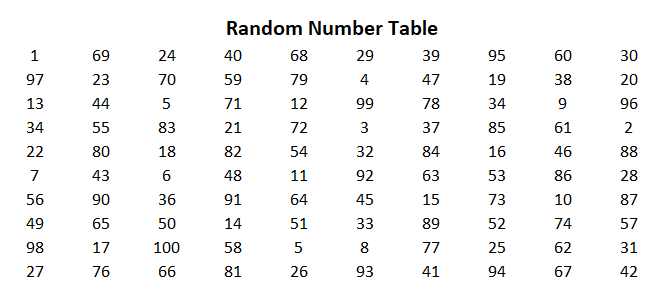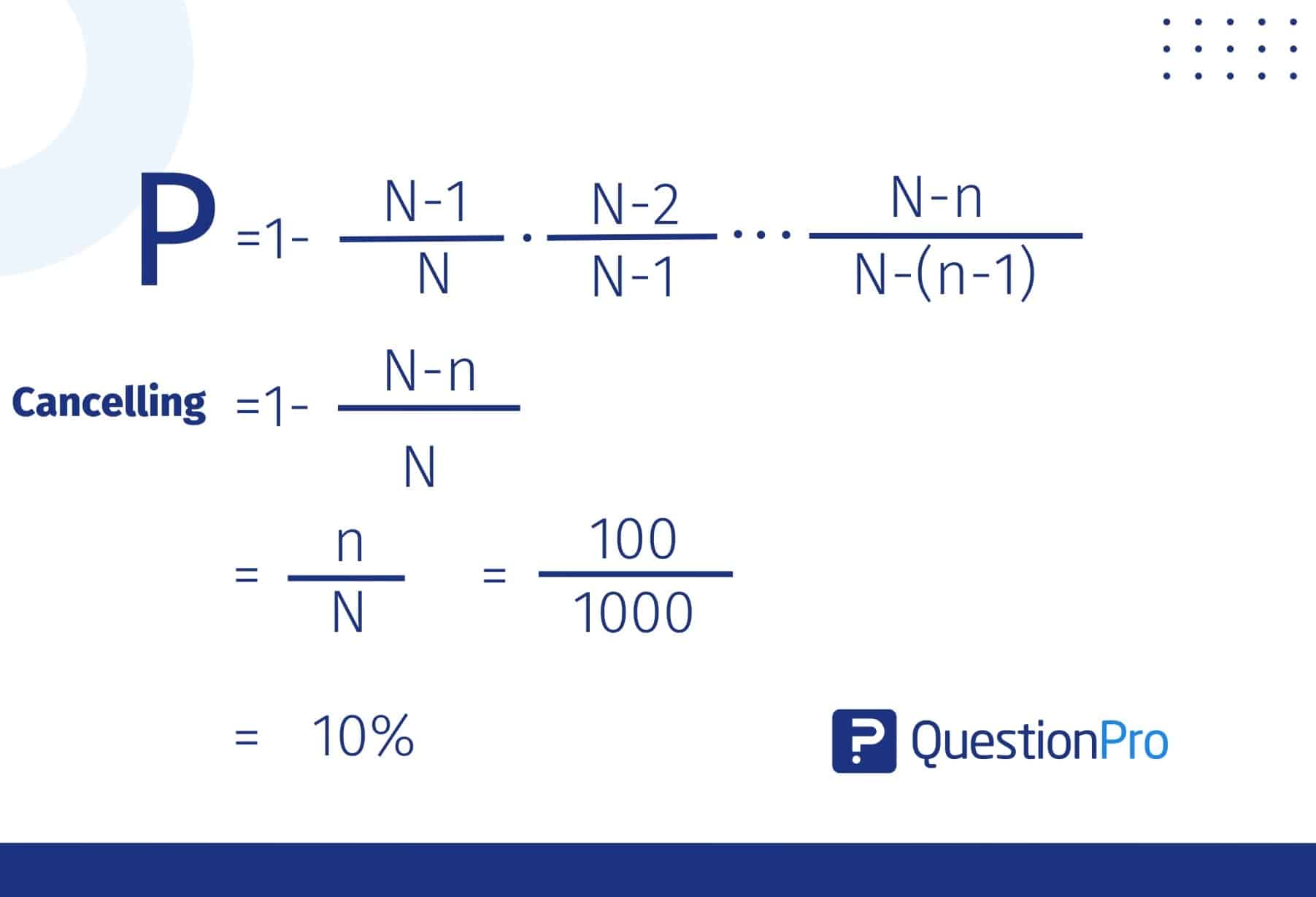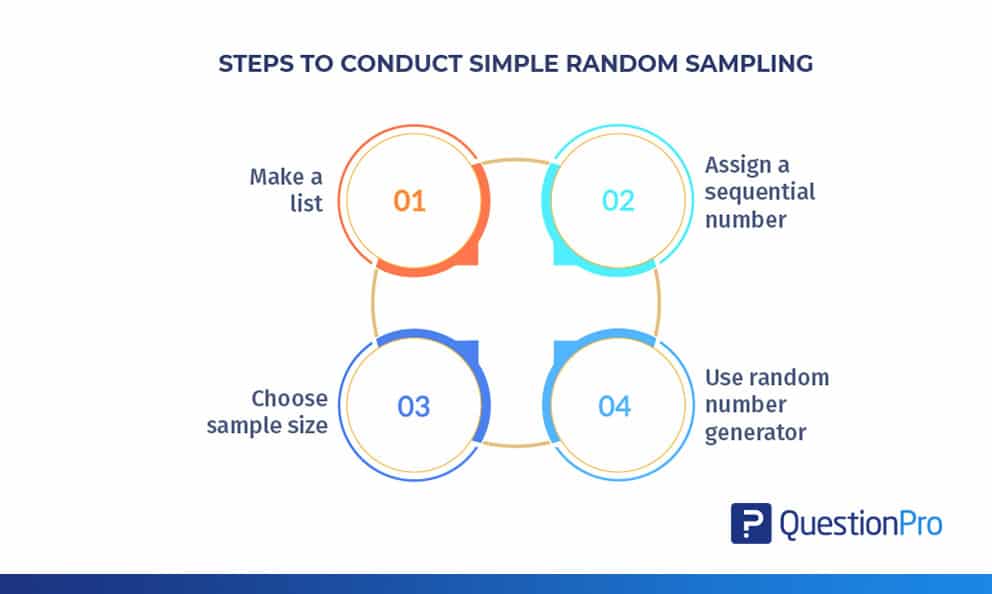
Simple random sampling is a statistical method in which everyone in a population has an equal chance of being selected into a sample. The sample represents a smaller and more manageable portion of the people that can be studied and analyzed. It’s a fundamental technique to gather data and make inferences about a population.
Simple random sampling is considered a fair and unbiased sample selection method. This type of sampling is the most straightforward sample selection bias method.
What is Simple Random Sampling?
Simple random sampling is a technique where every item in the population has an even chance and likelihood of being selected. Here, the selection of items entirely depends on luck or probability. Therefore, this sampling technique is also a method of chance.
Simple random sampling is a fundamental method and can easily be a component of a more complex method. The main attribute of this sampling method is that every sample has the same probability of being chosen.
The sample size in a simple random sampling method should ideally be more than a few hundred so that it can be applied appropriately. This method is theoretically simple to understand but difficult to implement practically. Working with a large sample size isn’t an easy task, and it can sometimes be challenging to find a realistic sampling bias frame.
Simple Random Sampling Methods
Researchers follow these methods to select a simple random sample:
- They prepare a list of all the population members initially, and each member is marked with a specific number ( for example, if there are nth members, then they will be numbered from 1 to N).
- Researchers from this population choose random samples using random number tables and random number generator software. Researchers prefer random number generator software, as no human interference is necessary to generate samples.
Two approaches aim to minimize any biases in the process of this method:
01. Method of lottery
Using the lottery method is one of the oldest ways and is a mechanical example of a random sample. Researchers draw numbers from the box randomly to choose samples. In this method, the researcher gives each member of the population a number.
02. Use of random numbers
Using random numbers is an alternative method that also involves numbering the population. A numbered table similar to the one below can help with this sampling technique.

Simple Random Sampling Formula
Consider that a hospital has 1000 staff members and must allocate a night shift to 100 members. All their names will be put in a bucket to be randomly selected. Since each person has an equal chance of being selected. Since we know the population size (N) and sample size (n), the calculation can be as follows:

- P = 1 – {( N – 1 ) / N } . ( N – 2) / ( N – 1) . . . (N-n) / {N – ( n – 1 )}
- Cancelling = 1 – {( N – n ) / N }
= n / N
= 100 / 1000
= 10%
Simple Random Sampling Steps
Simple random sampling is a crucial method in statistical analysis for drawing unbiased conclusions about a population. Below are the steps to perform simple random sampling to select a sample of 100 employees out of a total of 500 in an organization.

Step 1: Make a List
To start simple random sampling, first, make a complete list of all 500 employees in the organization. It’s important that the list includes the names of every employee to guarantee that each person is considered.
A precise and thorough list is crucial to ensure the sampling accurately reflects the entire population.
Step 2: Assign a Sequential Number
After creating the list of employees, the next thing to do is give each employee a number in order. This is your sampling frame (the list from which you draw your sample). This numbering helps organize the list, making identifying each person in the group easier.
Every employee should have their own number, starting from 1 and going up to n, which is the total number of employees in the organization.
Step 3: Choose Sample Size
Selecting the right sample size is important in simple random sampling. In this situation, we’ve chosen a sample of 100 employees from a total population of 500. It’s essential to pick a sample size that’s large enough for dependable results but still practical for analysis.
Step 4: Use a Random Number Generator
To choose a sample from the group, use a random number generator. First, find the total number of people (Step 2) and decide how many we want in our sample (Step 3).
Then, use a random number table or generator to create 100 different random numbers between 1 and 500. These numbers match the order given to each employee, which helps you pick who will be in the sample.
This method ensures that each employee has an equal opportunity for selection, maintaining fairness and impartiality in sample selection.
It is important to note that Simple Random Sampling is just one of many sampling methods available, and it may not always be the best option for your specific research needs.
Simple Random Sample vs Other Sampling Methods
When thinking about how to sample, people often look at different methods like simple random sampling, stratified sampling, systematic sampling, and cluster sampling. Each method has its pros and cons, so it’s crucial to choose the right one depending on what you’re studying and the features of the group you’re looking at.
Simple vs Stratified Random Sample
The simple random sampling techniques and stratified random sampling have different ways of choosing samples from a population.
- Simple Random Sampling:
- Involves the entire population of data.
- Every person or item is equally likely to be chosen.
- Stratified Random Sampling:
- Separates the population into groups with similar characteristics.
- Samples are selected independently from each group.
Simple vs Cluster Sampling
While simple random samples treat each individual in the population as a potential sample unit, cluster sampling involves grouping individuals into clusters or natural units before selecting samples.
- Simple Random Sampling:
- No clusters or divisions within the population.
- Each individual has an equal chance of selection.
- Cluster Sampling:
- Depends on one or more clusters.
- Groups individuals into clusters, and then samples are selected from these clusters.
Simple vs Systematic Sampling
Systematic sampling involves selecting samples at regular intervals after starting randomly.
- Simple Random Sampling:
- No starting point or predetermined pattern.
- Each individual has an equal chance of selection.
- Systematic Sampling:
- It involves choosing samples at regular intervals after a random start.
- It can be easier to implement but may lead to biased results if patterns exist in the data.
LEARN ABOUT: Purposive Sampling
Simple Random Sampling in Research
Today’s market research projects are much larger and involve an indefinite number of items. It is practically impossible to study every member of the population’s thought process and derive interference from the study.
If, as a researcher, you want to save your time and money, simple random sampling is one of the best probability sampling methods that you can use. Getting data from a sample is more advisable and practical.
Using a census or a sample depends on several factors, such as the type of census, the degree of homogeneity/heterogeneity, costs, time, feasibility of study, the degree of accuracy needed, etc.
Advantages of Simple Random Sampling
Simple random sampling has several advantages, including:
- It is a fair sampling method, and if applied appropriately, it helps reduce any bias involved compared to any other sampling method.
- Since it involves a large sample frame, it is usually easy to pick a smaller sample size from the existing larger population.
- The person conducting the research doesn’t need to have prior knowledge of the data he/ she is collecting. One can ask a question to gather the researcher need not be a subject expert.
- This sampling method is a fundamental method of collecting the data. You don’t need any technical knowledge. You only require essential listening and recording skills.
- Since the population size is vast in this type of sampling method, there is no restriction on the sample size that the researcher needs to create. From a larger population, you can get a small sample quite quickly.
- The data collected using this sampling method is valuable. The higher the number of samples, the better the quality of the data.
Overall, this is a valuable and versatile method for gathering data and making inferences about populations.
Disadvantages of Simple Random Sampling
Simple random sampling has some drawbacks that can affect the relevance of the collected data:
- Sampling errors may happen if the sample doesn’t accurately reflect the intended population.
- Excluding specific groups could lead to skewed results because of imbalanced population demographics.
- Analyzing research results from simple random sampling can be time-consuming and expensive, especially depending on the data’s size and format.
- The sample’s random selection may cause differences in the representation of the population.
- Inaccurate results may arise due to non-response bias when certain groups choose not to participate in the research.
LEARN ABOUT: Survey Sampling
Conclusion
Researchers use simple random sampling in statistical analysis methods valuable for various applications. Selecting a sample of individuals from a population in a random and unbiased manner provides a representative sample and a cost-effective way of gathering data and making inferences about populations.
With QuestionPro, researchers and data analysts can easily and efficiently implement simple random sampling in their research and studies. We are here to help to ensure that the results are accurate.
If you’re a market researcher trying to learn more about your target audience or a social scientist aiming to study a population, Simple Random Sampling with QuestionPro is a dependable and efficient method to explore.







